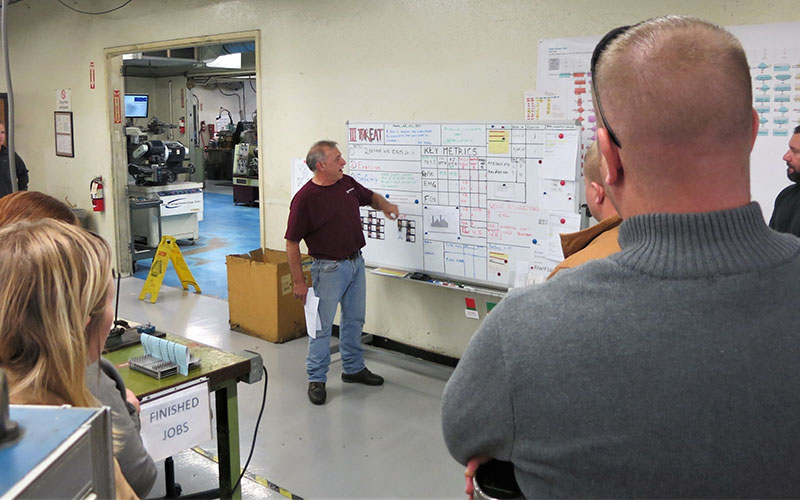
By Jon Kantola, project manager, RobbJack Corporation
A few simple Lean tools build a foundation for sustained Lean improvement. Surprisingly, Lean Manufacturing attempts fail an estimated 70% to 90% of the time, even when organizations have the best intentions when it is implemented. Companies that succeed with Lean realize that it requires a long-term effort at culture change, a new way of thinking that senior management champions daily. They drive a focus on increasing customer value rather than on internal cost reductions, understanding that providing what customers want, when they want it, for the right price will increase sales revenue. Daily Lean activity to improve processes that drive customer value will result in cost savings.
Another key to success is in how Lean is introduced to the company. Consultants often are hired to train staff in key concepts and tools during a “Lean implementation,” but the goal should be an evolution of the “company Lean way” that morphs the consultant’s instructional content into a best fit culture for your organization. If you study Toyota methods, apply the concepts that click with your team, but do not try to become Toyota. Learn and use the right Lean tools for the moment and for your team, then put those that do not work back in the toolbox. There are some foundational tools that managers and staff will use every day that should be incorporated into your “company Lean way” from day one. These tools go after the low hanging fruit of improvement company-wide, from the office to the shop.
GEMBA walks
Senior managers are change agents, advocates, mentors and cheerleaders for the company’s Lean initiatives, regardless of how busy they are or their personal Lean skillset. GEMBA is a Japanese concept developed by Taichi Ohno that helps busy managers maintain Lean momentum “where work gets done.” It has three main principles: Go and see, ask why and respect people. Managers are challenged to walk through the shop and offices to observe work conditions, monitor improvement projects, check on key process metrics, and mentor and encourage staff. The team at RobbJack Corporation in Lincoln, California, has taken GEMBA a step further and incorporated internal audits with a “kamishibai” card system, which simply is a visual indicator that an assigned action has been completed. In this case, when the green side of the card is visible on the department huddle board, the department passed the audit. A red card means the employees have an issue to address.
Each GEMBA card has several questions and example answers related to Lean concepts, standard work, vision/mission/strategy or one of the ISO 9000 elements. Five of these cards are placed in each work center and office, and managers are assigned a department and card via an automated system. They perform the GEMBA at their convenience, but within a scheduled timeline, and record their observations in SharePoint. The advantage of this system is that managers have a “script” of three simple questions, phrased so employees easily understand and learn what is required, and the GEMBA takes no more than 10 minutes to complete. With eight managers rotating through five cards in 10 departments every two weeks, employees continually are reinforced, the ISO 9000 audit record is extensive and managers frequently are observing how well these next Lean tools are being implemented.
5S Organization
Parents understand the frustration of a teenager’s bedroom, watching their child search for a pair of shoes in various piles so as not to be late to school. The goal of 5S organization is to establish a clean, efficient and waste free foundation for Lean to happen, to expose improvement opportunities lost in clutter – like shoes in a teenager’s room. This Lean concept comes from five Japanese words that loosely translate to Sort, Set in Order, Shine, Standardize and Sustain.
Begin a 5S cycle by Sorting through equipment, tooling, fixtures, supplies, furniture, etc., within each work center to identify what can be removed. Everything retained then should be Set in Order with a controlled location. Shadow boards, drawer inserts with cutouts and floor outlines are examples that immediately identify where items belong. Next, clean your floor, tools and equipment to make them Shine. Maintenance issues quickly are identified when not buried under a buildup of gunk, reducing equipment downtime. The first three 5S steps need to become Standard work, part of the daily Lean routine with checklists, schedules, instructions or similar mechanisms that encourage good housekeeping
habits. Although 5S is an ongoing cycle of sorting, ordering, shining and standardizing, it is Sustained when it becomes part of the culture. Managers can reinforce and sustain 5S during their GEMBA walks.
Value Stream Mapping
In its simplest form, a value stream map is a flowchart of your order-to-cash business processes, perhaps created first with Post-it Notes on a whiteboard. Adding specific information to each operation – like cycle time, setup/changeover time, uptime, queue time, shifts and manpower – helps your team visualize how product moves through the shop and prioritize improvement actions. Start with a current-state map of how things are done today, and then build a future-state map for each product family with common operations or machines and similar costs. These product-based value streams are cross-functional, with order-to-cash responsibility eliminating department “silos” that isolate staff into protective bubbles.
At RobbJack, for example, there are five value streams: PCD tools, slitting saws, large diameter end mills, small diameter mills and PVD coatings. Each has a unique set of equipment and staff responsible for satisfying customer demand, from order entry through shipping. Orders flow through a value stream with common goals, improved collaboration, good communication and transparent metrics. Problem-solving and continuous improvement are performed by each cross-functional team, with members representing order-to-cash functions.
PDCA Continuous Improvement
Value Stream teams use another vital and simple Lean tool for continuous improvement: the Plan, Do, Check, Act (PDCA) cycle that begins when a problem or opportunity is identified. The bulk of work is performed in the first step of the cycle, where problems are clearly defined, target outcomes are established, data collection tools are created and the actions to be taken are set with accountability and due dates. PDCA plans should scope to short, quick actions that prove or disprove an idea or solution within a week or two. Anything longer should be divided into multiple PDCA activities. Limiting change is equally important, lest too many adjustments to process variables obscure the root cause of a problem or the single factor contributing the greatest improvement.
The next three steps often blur together as teams execute the plan, collect data on the results and act based on their observations. RobbJack’s PDCA record is on A3 size paper, allows for six separate cycles, shows the plan with accountability and reports the results and findings. Although data collection is on other forms, the PDCA record allows
only enough space for about two weeks of do, check and act. When the team runs out of space, they need to restate
the objective and start a new cycle.
Huddle Boards
The foundational cornerstone and home base of value stream activity is a “huddle board,” a large whiteboard that displays each team mission and company strategy, current staffing status, key performance metrics and tracking charts, PDCA cycle records and GEMBA cards. All teams gather daily for a 10-minute stand-up meeting to review each subject on the board, highlight plans for the shift and discuss any PDCA findings. Members take turns leading the huddle meetings to promote engagement, participation and understanding of what is on the board.
Foundation for Success
Organizations that embark on a Lean journey are making a significant investment in consulting, training, infrastructure and time. They also commit to disrupting the status quo in which many employees are comfortable and the reason why most companies fail to break free from their traditional culture. To encourage ongoing and sustained change, senior management must “know the way, show the way and go the way” with a strong Lean foundation built on a few important tools. GEMBA walks encourage managers to interact with value stream teams and to monitor 5S organization and PDCA continuous improvement progress. Huddle boards not only ensure transparency, collaboration and communication, but also are the perfect time for managers to reinforce why Lean is so important: Delivering the highest customer value possible is the surest strategy for success.
 Jon Kantola has practiced Lean and continuous improvement in manufacturing operations for over 30 years as a production manager, quality manager, program manager, certified quality engineer and contract trainer. He has helped companies find “their Lean way” in the OEM automotive, performance automotive aftermarket, aerospace, sintered metal and cutting tool industries. He is a project manager for RobbJack Corporation and can be reached by emailing jon@robbjack.com.
Jon Kantola has practiced Lean and continuous improvement in manufacturing operations for over 30 years as a production manager, quality manager, program manager, certified quality engineer and contract trainer. He has helped companies find “their Lean way” in the OEM automotive, performance automotive aftermarket, aerospace, sintered metal and cutting tool industries. He is a project manager for RobbJack Corporation and can be reached by emailing jon@robbjack.com.


